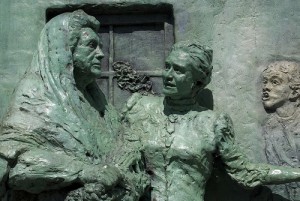Faith Healers Still a Big Part of Latino Health Care
 We joke among ourselves about getting a barrida or limpia to bring balance to a rash of bad luck or having a curandera do quick work to heal what ails us. “I know a lady who can fix that with an egg,” is as confounding to people who don’t understand as it is funny, and even an option, to those who do.
We joke among ourselves about getting a barrida or limpia to bring balance to a rash of bad luck or having a curandera do quick work to heal what ails us. “I know a lady who can fix that with an egg,” is as confounding to people who don’t understand as it is funny, and even an option, to those who do.
If you’re smiling or nodding in agreement you know what I’m talking about.
Faith healers are a mainstay of many Latino families, especially among recent immigrants. In part because of tradition and in part because many families can’t afford a doctor’s visit, the business of faith healers is thriving in Latino communities across the country.
A recent tragedy, reported in the Las Vegas Sun, brought the story to light:
In downtown Las Vegas, Colombians Ruben Matallana-Galvas, 55, and his wife, Carmen Olfidia Torres-Sanchez, 47, were charged with murder for injecting Elena Caro, 42, with silicone in her buttocks in the back of a tile store on East Charleston Boulevard. Caro had wanted to enhance her backside; instead she ended up dead. Matallana-Galvas told authorities he was a homeopathic doctor in Colombia.
First of all, a bigger backside is not exactly a health emergency, and secondly this type of tragedy happens across the country and is prompted by people wanting a quick fix to a elective problem – it’s not exclusive to the Latino community. Still, the incident served to open a conversation about Latino faith healers, homeopaths and snake oil peddlers.
Welcome to the highly developed, long existing world of alternative medicine as practiced in Hispanic communities in Las Vegas and across the U.S. These botanicas and other medical venues — improvised or not — are favored by people who can’t afford Western-style care or have little interest in doctors who don’t understand the highly ingrained, ancient ways many cultures have when it comes to their healing practices.
Many of us grew up with family faith healers and elders who prescribed an assortment of herbs that cured everything from belly aches to broken hearts. My mother was a western-trained registered nurse, but we had savila (aloe) growing in front of our house because it was both good for warding off evil intentions and, when split open, the perfect salve for scraped knees, cuts and insect bites.
Latinos have depended on curanderos and the like because of long-standing tradition and because faith healers address a dimension that cold doctor’s offices don’t.
“They don’t just take a pill, they believe in the spiritual healing, the mind-body-soul connection, and they go to their curanderos in part because they have this component. In Latin America, doctors spend a lot more time talking to their patients,” he said. “We don’t have this thing where a doctor is writing a prescription five minutes after they’ve walked in the office, already on their way out. It’s not uncommon for a doctor to spend up to an hour with their patient. You don’t find that here.”
The problem is that western medicine becomes the option of last resort, when the patient is too sick for other remedies, and many times folk healing only makes matters worse.
The main problem with alternative medicine is it can extend the amount of time before a patient turns to a doctor for help, by which time a patient’s condition may have turned serious, he said. Coupled with that are the cultural and educational barriers that prevent many families from integrating into a medical system that they don’t understand.
Dependence of faith healers can be linked to education, and it shouldn’t surprise us. The more education a person has the more they will seek medical care from a hospital or medical Doctor.
When I was a kid we had both. Mom took us to see the doctor, but the curandera was always an option, for good measure.
Follow Victor Landa on Twitter: @vlanda
[Photo by LuaCheia72]
